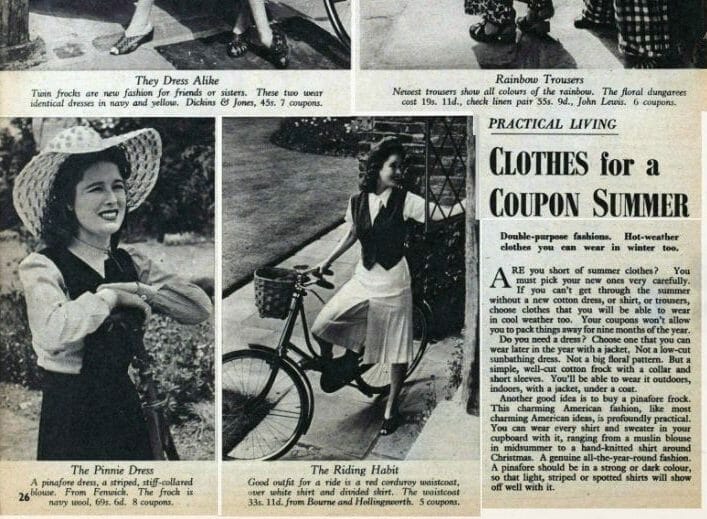The New Year often brings a sense of “out with the old, in with the new”. For the fashion-conscious, it’s a good excuse to revamp ones wardrobe and go shopping. These days it’s easy to buy new clothes every season, but it was very different during the Second World War. Then, clothing was rationed and had to be reused as much as possible. Once the war was over, the “out with the old” attitude finally prevailed over rationing, culminating in Christian Dior’s ground-breaking ‘New Look’. I used Picture Post and other newspaper archives in Gale Artemis: Primary Sources to track changing attitudes to fashion in the newspapers and magazines of the time.
In June 1941 the British Board of Trade introduced clothes rationing, granting an allowance of 66 coupons per household for the year. To most this meant having to “make do and mend”, with women encouraged by President of the Board of Trade Hugh Dalton to carry a needle and thread with them at all times. Those who wanted to maintain their interest in fashion were required to think creatively, resulting in designs that used less material and that were as versatile as possible. A spread in the Picture Post shows off designs that will last all year – light summer dresses with collars and sleeves for winter, and pinafore dresses that can be worn over shirts of any thickness.

Another Picture Post issue that month featured a coat that could convert into a bedspread!

Gradually practical, economical clothing became the norm, raising the hemline to save on fabric, and doing away with all embellishment.
Clothes rationing continued well beyond the war years, and even before peace was declared patience with “make do and mend” was beginning to wear thin. As a writer for the Picture Post put it, “Naturally, women who have worn uniform, or patched for six years, want gay, pretty and essentially feminine clothes as soon as possible”. Entrée Dior.
In 1947 Christian Dior was relatively unknown, designing for Lucien Lelong before launching his own collection that year. His new line, christened the ‘New Look’, was an instant success. Feminine, elegant and using vast quantities of material, it was a far cry from the utilitarian dress that British women were used to.
The hemline dropped to well below the knee, skirts were either very full or ‘hobbled’ women if they were pencil cut, and the tightly pinched-in waist became a defining characteristic. Practicality and economy had given way to elegance and luxury.

The ‘New Look’ was greeted with both excitement and vexation in Britain. Mary Delane, reporting from Dior’s launch for the Sunday Times, said “The enthusiastic reception given to these supremely elegant clothes was well deserved… Dior’s exquisitely swinging pleated skirts…have to be seen to be believed”3. But the excessive fabric frustrated those who still had to abide by the restrictions of rationing. As a Picture Post writer noted drily: “Paris forgets this is 1947”. Many women preferred short hemlines, and began to look back on the days of shorter skirts with nostalgia (“And so, a last look at the Old Look” Daily Mail [London] 29 Mar. 1948). American women were not keen on the longer skirts either (“Christian to face the Amazons” Daily Mail [London] 2 Sept. 1947), and eventually Dior bowed to pressure and introduced gowns with the same glamourous characteristics but with a shorter hemline. In doing so, the cocktail dress was born.


